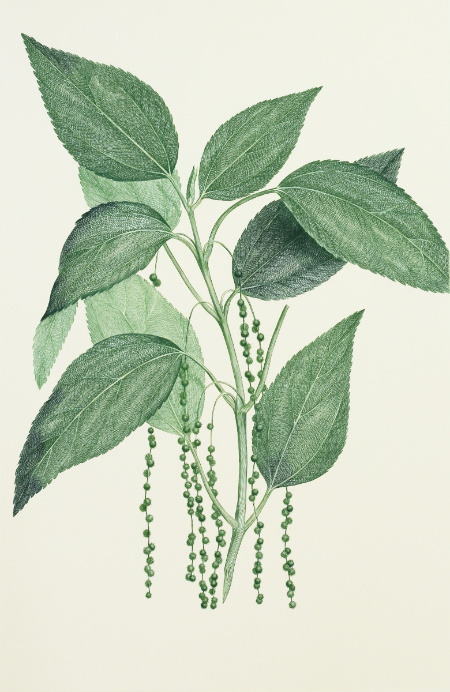
SYDNEY PARKINSON (artist)
‘Plate 657. Boehmeria Virgata (G. Forster) Guillemin, Urtica virgate (Urticaceae)’
London: Alecto Historical Editions in association with the British Museum (Natural History), 1980-1990
Engraving by Gabriel Smith, printed à la poupée by Alecto Historical Editions
Limited to 116 impressions, this no. 83 of 100 and numbered 83/100
❧ BOEHMERIA VIRGATA (G. FORSTER) GUILLEMIN, URTICA VIRGATE (URTICACEAE)
Species collected at Tahiti, Society Islands
13 April – 1 June 1769 and 4 June – 13 July 1769
In the decade prior to HMB Endeavour’s circumnavigation, the British had sent several Royal Navy vessels to the Pacific to explore the territories and trade opportunities. Samuel Wallis, the first European to visit Tahiti (then called Otaheite) in 1767, returned to England with news of an island he had named ‘King George the Third’s Island’. Cook then selected Matavai Bay as the location for his observation of the transit of Venus in June 1769.
Since Wallis’ and (in 1768) Bougainville’s visits to Tahiti had been friendly, ‘when the Endeavour anchored on 13 April [1769] in Matavai (Port Royal) Bay, a great number of Tahitians in canoes, bearing branches of Thespesia populnea as symbols of peace and friendship and coconuts, breadfruit and fish as objects of barter, soon came out to the ship’ (Stearn, ‘A Royal Society Appointment’, p. 103). While Cook, the astronomer Charles Green, and also Daniel Solander prepared for and observed the transit of Venus, Banks utilised much of the time to explore the local vegetation.
This plant of the nettle family, Boehmeria Virgata, is indigenous throughout Southeast Asia. A shrub or slender tree, it grows between one and eight metres tall and is mostly harvested for its fibres for sacks, rope, etc. The leaves are also said to have medicinal properties, and are used for example in dressings for broken bones.
SPECIFICATIONS
The engravings are all of a very similar size, with platemarks of circa 457 x 305mm, and are printed on acid-free Somerset mould-made 300gsm paper manufactured by the Inveresk Paper Company. Each sheet is watermarked ‘AHE’, measures 724 x 556mm, and bears blind embossed stamps incorporating the publishers’ and printer’s chops, the copyright symbol, and date of publication; the initials of the individual printer, the plate number, and the edition number are recorded in pencil. The engravings are protected by a bifolium of acid-free Somerset mould-made 300gsm paper, cut to form a window mount on which is recorded the modern and Banksian names of the plant, the location and date of its collection and the name(s) of the artist and engraver.
This print accompanied by a certificate of limitation.
This print is no longer available.
© Type & Forme and Alecto Historical Editions/Trustees of the Natural History Museum 2020

